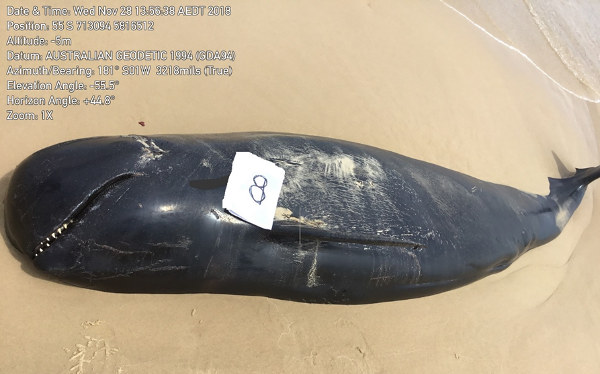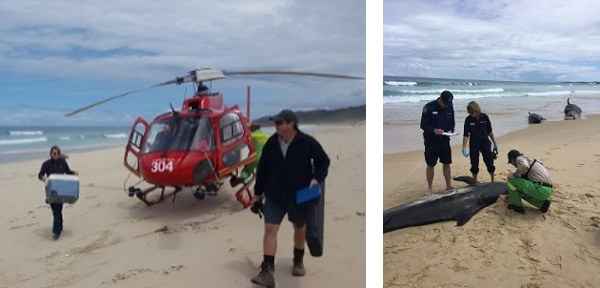Whale stranding at Point Hicks

Dianne Philips
Senior Veterinary Officer, Agriculture Victoria
On Wednesday 27 December 2018, Agriculture Victoria received a request from Department of Environment, Land, Water and Planning (DELWP) wildlife officers for a veterinarian to assist with a pilot whale stranding east of Point Hicks in East Gippsland.
The stranding had been identified the afternoon before. At that time, along a one-kilometre section of beach, four whales were identified as alive with a further 23 pilot whales and one humpback already dead.
Access to the beach was via helicopter, a trip of about 30 minutes from Orbost. On arrival, the veterinarian assessed the two surviving pilot whales (two had died in the intervening period) and the decision was made to humanely destroy them.
Monitoring for signs of death in whales are similar to other mammals and include:
- absence of corneal reflex
- dilation of pupils
- loss of jaw tone
- loss of tongue withdrawal
- cessation of respiration.
Approved techniques for humane destruction for whales up to six metres include prescribed firearms and use of sedation followed by lethal injection. Use of injectable agents that leave toxic residues in the carcass can only be used where the carcass can safely be disposed by burial or other suitable means, to avoid any issues with wild scavengers. In this case the decision was made to use firearms.
All the carcasses were assessed and measured, using a standard set of parameters that Museum Victoria collect for analysis. Skin and blubber samples are also collected and stored frozen for future investigation.

The stranded pilot whales were a mixture of males and females of different maturity and included two females with young calves and a pregnant female. They appeared to be in good body condition, although they had varying levels of superficial signs associated with dehydration and exposure, such as peeling of skin and keratitis. The humpback whale carcass appeared to be older and was probably unrelated to the pilot whale mass stranding.
Mass strandings are more common in some cetacean species than others and are limited to species of toothed whales and dolphins (Odontocetes). The exact cause of mass strandings is not well understood, but local environmental conditions such as tides, storms, local landforms and currents are considered to be influential.
Previous stranding events
In this coastal area of East Gippsland, a previous stranding of over 80 pilot whales was recorded in 1983. At the same time as the current stranding, perhaps coincidentally, another stranding of 145 pilot whales, followed by a stranding of 10 pygmy whales was reported in New Zealand. There were also two more whale carcasses that washed up on the Gippsland coast, further east toward Mallacoota.
Generally mass strandings are much less common than single strandings of cetaceans, which typically involve animals that appear clinically unwell or where abnormalities may be detected at necropsy.

Contact information
Cetacean strandings and entanglements are designated emergencies under the Emergency Management Act 1986 and DELWP are the control agency. Any incidents involving cetaceans in Victoria can be reported to the Cetacean Emergency Hotline 1300 136 017.